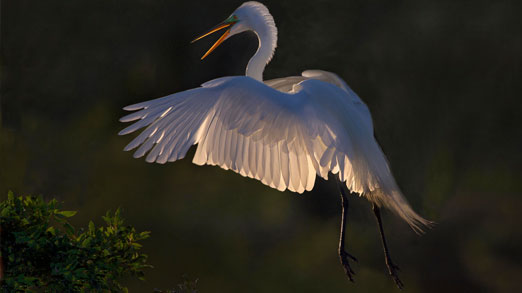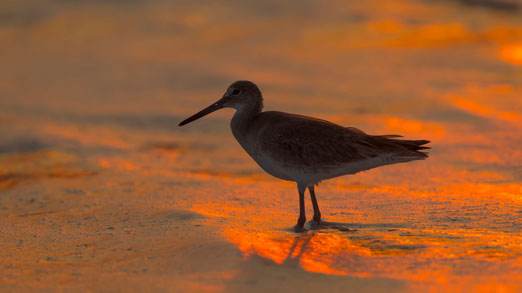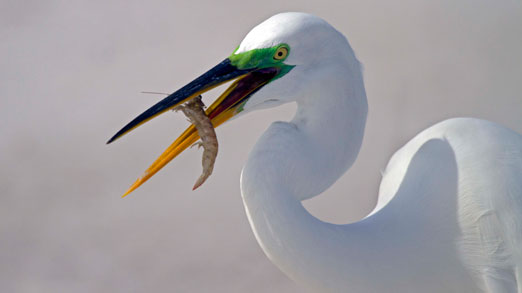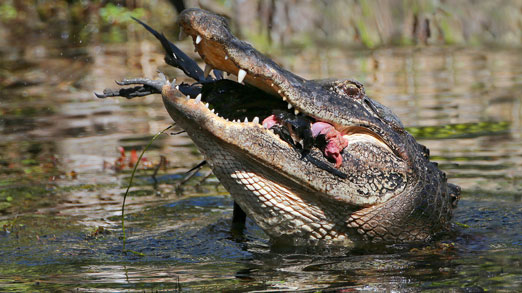
|
Wild
Florida
Florida is rightly regarded as one of the world’s foremost natural history destinations, with hundreds of miles of coastline that contain lagoons, mangrove swamps and sandy beaches. Couple this with a low lying interior filled with a myriad of waterways, swamps, boggy areas and woodland and one can see why it is such a magnificent habitat for a whole host of wildlife. Although the Photoventures tour will concentrate on the bird life that is abundant in the state, there will of course be many opportunities to see other wildlife as we visit some of the real wildlife hotspots during our tour.
The tour will begin in the Tampa area with a visit to both Honeymoon Island and Fort De Soto State Park. At Honeymoon Island you will be able to photograph a wide range of waders and water birds along the causeway joining the island to the mainland, before we venture onto the Island to photograph Ospreys and other birds. At Fort De Soto we will have the opportunity to photograph herons, egrets, pelicans, terns and a wide variety of waders and smaller birds. A walk along the shoreline here offers a whole host of exciting prospects. While we are there, keep an eye out for the strange horseshoe crabs and fish that are often found along the shoreline. From Tampa we travel south to Venice Rookery, a small area which has two lakes, one of which is home to many nesting water birds. We will have an evening visit to the rookery to capture the birds flying into their roost. On the following morning we can photograph great blue herons, great egrets and anhinga at their nests on a small island in the lake. This is also a great spot for flight shots as the birds bring in nesting material. Of course, there will be many more bird species found around the lake.
From Venice we continue south to Fort Myers, another wildlife hotspot. The most famous of these is the J.N. Ding Darling Wildlife Reserve on Sanibel Island. We will of course be spending ample time exploring this great haven for water birds of all kinds. A whole range of birds are found on the reserve including white and glossy ibis, black and yellow crowned night herons, reddish, snowy, cattle and great egrets, anhinga, roseate spoonbills, great blue, little blue, green and tri-coloured herons as well as a host of other birds. Fort Myers offers other great locations that include the burrowing owl sites in Cape Coral, also close by is a bald eagle location and hopefully the nest site will be active. Other great locations include Carl E Johnson/Lovers Key Reserve. Here one can find waders, herons, ospreys and terns to name just a few. During our stay here, we will detour to Corkscrew Swamp and, if we are lucky, may see the rare painted bunting, one the most colourful birds in the USA.
From Fort Myers we continue south through Big Cypress. The road is lined with small waterways that are often full of alligators and of course bird life. At Monroe Station we make a detour down the loop-road to a quiet swamp area rich in wildlife before we continue south to Florida City stopping along the way to enjoy an optional airboat ride into the heart of the ‘glades’. Florida City is our base to visit one of America’s most famous National Parks, The Everglades. We will have three nights in this location and take daily excursions into the ‘glades’ visiting wildlife hotspots. The best of these is the Anhinga Trail at Royal Palms, a veritable haven for wildlife photography. This small area offers endless opportunities to photograph a wide variety of birds that are often very close indeed. Among the birds found here are many types of heron, wood storks, varieties of ibis, bitterns, purple gallinule, vireos and on a previous visit a smooth billed ani was photographed here - a very rare bird only found in the extreme south of Florida and the Caribbean. This is also one of the best locations to photograph birds as they catch fish and struggle to eat them. Also found here are a large number of alligators and fresh water turtles. This part of the everglades also offers many other interesting locations including Flamingo and other wooded groves where birds such as red shouldered hawks, ospreys and kestrels can be found. There are also a number of ponds that may allow us to photograph roseate spoonbills, black necked stilts and other water birds. The days spent here will offer a wonderful wildlife experience that should provide a host of photographic possibilities.
From here we journey north to the Delray Beach area where we spend our final two days visiting both the Wakodahatchee and Green Cay Wetlands. Wakodahatchee is built on an old water treatment works and is a series of board walks giving access to a fantastic array of birds, reptiles and mammals. This wetland will provide the chance to see raptors and perhaps glimpse the rare sora rail, least bittern or the swamp rabbits as they appear at dusk amongst the margins. Green Cay is a relatively new wetland area and, with 1.5 miles of board walk, offers access to open water, vegetated wetland and mudflats. Although this reserve is relatively new it is set to be one of the very best on the Atlantic Coast. |





